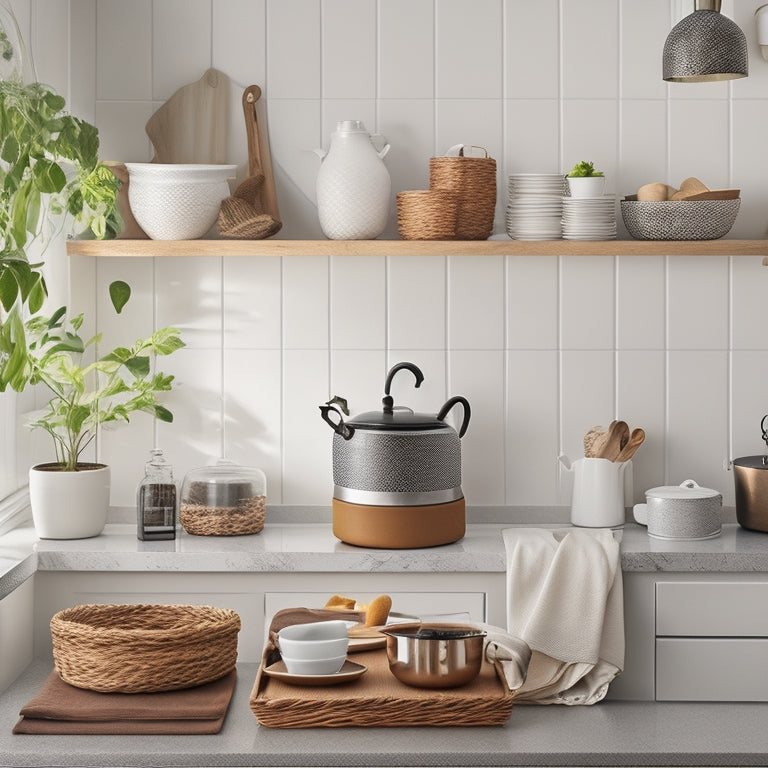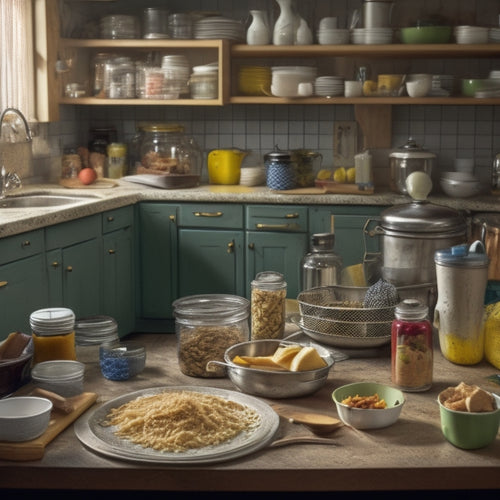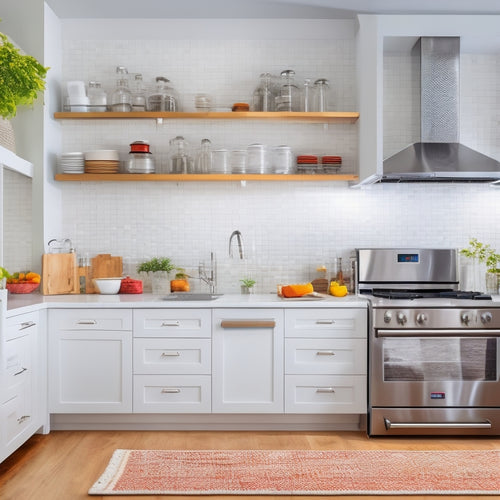
Simplify Your Space: Kitchen Hacks for Busy Moms
Share
You're tired of feeling overwhelmed in your kitchen, where clutter and disorganization are stealing your time and energy. Start by clearing countertops and assigning homes for items, utilizing space-saving solutions and quick decluttering tips. Next, maximize storage efficiency by installing vertical shelf dividers and lazy susans, freeing up counter space for daily essentials. Streamline your workflow by designating task-specific areas and equipping them with necessary tools. By implementing these simple yet effective strategies, you'll be well on your way to a more efficient, stress-free kitchen - and there are even more game-changing hacks waiting to be discovered.
Key Takeaways
• Clear countertops by assigning homes for items and utilize space-saving solutions to reduce clutter and increase productivity.
• Maximize storage efficiency by installing vertical shelf dividers, lazy susans, and utilizing drawer dividers and utensil caddies.
• Streamline workflow and meal prep by designating task-specific areas, batch cooking, and planning meals weekly to save time.
• Maintain organization systems by scheduling regular maintenance sessions, implementing the 'one in, one out' policy, and cleaning as you go.
• Improve efficiency and time management by optimizing cabinet and drawer space, setting designated meal prep days, and utilizing slow cookers for hands-off cooking.
Decluttering Kitchen Countertops Fast
Since you're always on the go, establishing a system that allows you to declutter your kitchen countertops quickly and efficiently is essential, so you can focus on more pressing tasks. To achieve a clutter-free kitchen, adopt a minimalist kitchen design that prioritizes functionality over aesthetics.
Start by clearing everything off your countertops and sorting items into categories. Then, assign a home for each item, ensuring it's easily accessible and out of sight. Utilize efficient space-saving solutions like a utensil organizer, spice rack, or a knife block to keep frequently used items within reach.
Implement quick decluttering tips, such as wiping down countertops after each meal, storing appliances when not in use, and scheduling a weekly tidy session. By incorporating these habits into your daily routine, you'll enjoy clutter-free countertops that make meal prep a breeze.
With a few simple changes, you'll be able to reclaim your kitchen and focus on what matters most – your family and yourself.
Maximizing Cabinet Storage Space
By optimizing your cabinet storage space, you can stash away infrequently used items, freeing up valuable counter real estate for daily essentials and streamlining your kitchen workflow. To maximize your cabinet's potential, start by installing vertical shelf dividers to separate and categorize items. This will prevent clutter from building up and make it easier to find what you need quickly.
Consider adding rotating lazy susans to corner cabinets or hard-to-reach shelves, allowing you to access items without having to dig through the entire cabinet.
Next, utilize the often-wasted space under your cabinets by installing under cabinet hooks for hanging items like spices, oils, or cleaning supplies. Over door organizers can also be used to store snacks, cleaning products, or even cookbooks.
Streamlining Kitchen Workflow Zones
Your kitchen workflow zones, such as food prep, cooking, and cleanup, can be streamlined by designating specific areas for each task and outfitting them with the necessary tools and equipment. This will help you work more efficiently, saving you time and reducing stress.
For instance, designate a specific area for food prep, equipped with a large countertop, a sink, and time-saving kitchen gadgets like a food processor or a stand mixer. This zone should also have ample storage for utensils, ingredients, and cookbooks.
A functional kitchen layout is vital to streamlining your workflow. Consider a 'work triangle' layout, where your sink, stove, and refrigerator form the points of a triangle. This layout allows you to move quickly and easily between tasks, reducing walking distances and increasing productivity.
Additionally, consider investing in a kitchen cart or island to provide additional counter space and storage. By streamlining your kitchen workflow zones, you'll be able to cook, clean, and prep with ease, giving you more time to focus on what matters most – your family.
Meal Prep for Busy Schedules
When you're juggling multiple tasks and responsibilities, meal prep can be a game-changer, allowing you to cook healthy meals in advance and save time during the week. By incorporating meal prep into your routine, you can reduce stress and make sure that you're feeding your family nutritious meals, even on the busiest of days.
Here are some time-saving tips to get you started:
| Meal Prep Strategy | Benefits |
|---|---|
| Batch Cooking | Saves time during the week, allows for healthy meals in a flash |
| Freezer Meals | Prep meals ahead, freeze, and reheat as needed |
| Weekly Planning | Plan meals, make a grocery list, and shop accordingly |
| Portion Control | Prep individual portions for easy grab-and-go meals |
Organizing Kitchen Utensils Efficiently
To maximize your kitchen's efficiency, start by assigning a designated spot for each utensil, ensuring everything has its place and is easily accessible. This means utilizing drawer dividers to separate utensils like whisks, spatulas, and spoons, making them simple to find when you need them.
You can also use utensil caddies to store items like tongs, garlic presses, and can openers, keeping them organized and within reach.
Next, consider the vertical space in your kitchen. Install magnet strips on the side of a cabinet or fridge to store metal utensils like knives, scissors, and peelers. This will keep them organized, visible, and easily accessible.
You can also use hanging hooks to hang items like pots, pans, and colanders, freeing up cabinet space and keeping your countertops clear.
Creating a Kitchen Command Center
Now that you've optimized your utensil storage, take your kitchen's efficiency to the next level by designating a central hub for meal planning, grocery lists, and reminders, effectively creating a command center that streamlines your daily routine. This centralized space will become the nerve center of your kitchen, facilitating family communication and saving you precious time.
Choose a convenient location, such as a wall near the entrance or a corner of your kitchen counter, and equip it with a few essential tools.
A large calendar or whiteboard will help you plan meals and keep track of schedules.
Add a bulletin board or a corkboard for posting notes, reminders, and to-do lists.
Consider a small tray or basket to corral pens, paper, and other supplies.
Taming Kitchen Paper Clutter Chaos
Paper clutter can quickly spiral out of control in the kitchen, with receipts, coupons, and recipe printouts piling up on countertops and overflowing from drawers. It's time to take control of the chaos and create a paper organization system that works for you.
Start by designating a specific area for paper storage, such as a file organizer or a binder with labeled tabs. Sort through the clutter and categorize papers into folders, like 'recipes to try,' 'coupons to use,' and 'receipts to keep.'
Next, consider implementing paperless solutions to reduce clutter in the long run. Digital storage options like cloud-based apps or note-taking tools can help you store and access recipes, coupons, and receipts without the physical clutter.
You can also take photos of receipts and store them digitally, freeing up physical space in your kitchen. By implementing a filing system and embracing digital storage, you'll be able to quickly find what you need, reduce stress, and reclaim your kitchen countertops.
With a little effort, you can tame the paper clutter chaos and create a more organized, efficient kitchen.
Labeling and Signage for Clarity
You can create a sense of clarity and direction in your kitchen by assigning a name to each storage bin, shelf, and zone, making it easy to find what you need in a flash. This is where labeling and signage come in.
With a color-coded organization system, you can categorize similar items together, making it easy to identify what's inside each bin. For example, use red labels for baking supplies, green for cooking essentials, and yellow for snacks. Visual reminders like signs or stickers can also help you remember where things go, reducing clutter and saving time.
Take your labeling game to the next level by incorporating digital inventory systems. You can use apps or spreadsheets to keep track of what you have in stock, making it easy to plan meals and avoid duplicate purchases. And why not get creative with your labeling? Use fun fonts, icons, or even photos to make your labels stand out.
With creative labeling, you can turn a mundane task into a fun and personalized experience. By implementing these strategies, you'll be able to find what you need quickly, freeing up more time for the things that matter most.
Maintaining Kitchen Organization Systems
With your labeling and signage in place, it's time to establish habits that'll keep your kitchen organization systems running smoothly, ensuring that the clarity and direction you've created won't fade over time.
Schedule regular 'zone maintenance' sessions, where you dedicate 15-30 minutes to tidying up a specific area, like your pantry organization or fridge makeover. This will prevent clutter from building up and keep your systems functional.
Implement a 'one in, one out' policy for new kitchen items, ensuring that your space doesn't become overcrowded.
Designate a 'launching pad' near the entrance of your kitchen where family members can place their belongings, keeping them organized and out of the way.
Make it a habit to clean as you go, wiping down countertops and putting away dishes immediately after meals. This will prevent crumbs and spills from becoming sticky messes.
Frequently Asked Questions
How Do I Handle Kitchen Clutter That's Sentimental or Hard to Part With?
When decluttering, you're likely to face sentimental items with strong emotional attachments. Create a "maybe" box, set a deadline, and use organizing techniques like categorizing and grouping to help you decide what to keep and what to let go of.
Can I Use Baskets or Bins With Kids Who Like to Dig Through Them?
You wonder if using baskets or bins with kids who love to dig through them is a good idea. Research suggests it's a great way to teach toy organization and playful storage, as long as you childproof them with accessible solutions.
What Are Some Alternatives to a Kitchen Island for Added Counter Space?
You can expand your kitchen's counter space with alternatives to a traditional island, such as a rolling cart, wall-mounted table, over-the-sink shelf, or folding table, providing flexibility and functionality without sacrificing floor space.
How Do I Keep My Kitchen Organized When I Have a Large Family?
You keep your kitchen organized with a large family by implementing meal prep strategies, designating zones for each family member, and investing in storage solutions like baskets, shelves, and cabinet organizers to maximize space.
Are There Any Kitchen Organization Systems That Can Be Adapted for Renters?
You'll find flexible, temporary solutions for renters by opting for adaptable systems like removable shelves, hooks, and baskets that provide space-saving ideas without damaging the rental property.
Related Posts
-

What's Holding You Back From a Clutter-Free Kitchen?
You're struggling to achieve a clutter-free kitchen, and it's not because you're lazy or don't care. You're likely he...
-

Optimize Your Kitchen Storage With 7 Simple Hacks
You're already wasting valuable kitchen space without realizing it, and it's likely due to a lack of strategic storag...

